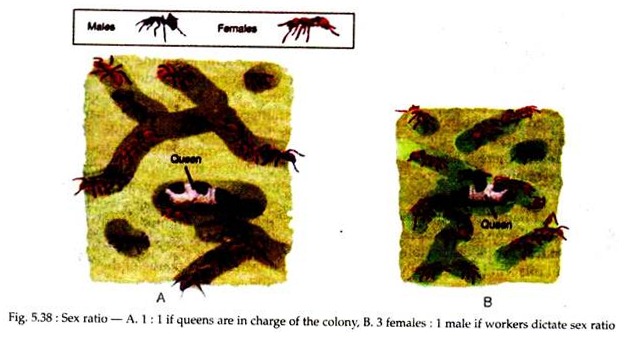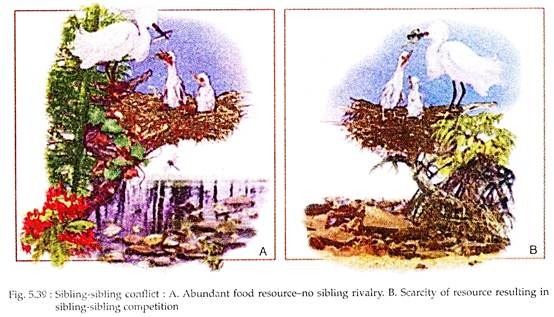In this article we will discuss about the two ways in which conflict occurs within families of animals:- 1. Parent-Offspring Conflict 2. Sibling-Sibling Conflict.
1. Parent-Offspring Conflict:
Parents and offspring have an average r of 0.5. Parents are willing to help their offspring even to a greater extent and, moreover, parents are always in a better position to help offspring than vice versa.
Among the parents, mothers in particular provide all sorts of aid to their offspring. It is because females are always certain that the young they help to raise are their own. On the other hand, males can only have some level of confidence in their paternity, as it is always possible that a given clutch of offspring were sired by another male. Such uncertainty reduces the resources which the males are willing to invest in young.
Moreover, females have a restriction in the number of offspring they can produce per unit time. Males, on the other hand, have a higher probability of producing large number of offspring per unit time (however, for the loser male it is a small number). The more a male mates, the more offspring he produces. Males, therefore, tend to invest more in multiple mattings and less in raising offspring.
ADVERTISEMENTS:
Parent-offspring conflict begins when the parent decides as to how much aid to give to any particular offspring, which is related to how much is available and how many offspring such a parent is likely to have in the future.
If a parent dispenses all the benefits it has at its disposal to a particular offspring and in doing so it kills the parent or severely hampers future reproductive possibilities, then it is not the wisest parental move in terms of the total number of offspring produced over the course of a lifetime. Therefore, there is always a limit on parental investment with respect to any given child.
On the other hand, from the child’s perspective, it values the resources for itself more than the resources for its other siblings. But, to a parent all offspring are equally valued. This, therefore, sets up a zone of conflict between how much an offspring wants to get from its parent and how much a parent is willing to give — and this results in parent- offspring conflict.
Example 1:
ADVERTISEMENTS:
Parent-offspring conflict during weaning:
One classical example of parent-offspring conflict is at the time of weaning. During weaning a young is made to get accustomed by the parents to a food other than the mother’s milk. At this time a zone of conflict becomes eminent as the mother will provide only so much milk for a current brood of offspring, as she must consider her life-time reproductive success. The current brood at this time is seen to beg for more milk than the maternal optimum.
Such a parent-offspring conflict was observed in mother-pup interactions by Malm and Jensen (1997), in Swedish Dachsbracken dogs. As pups reach seven weeks, the maternal optimum in terms of mother’s milk appears to have been reached, while the optimum of the pup has not been met. Therefore, parent-offspring conflict is witnessed as the mother declines milk to her still begging pups.
Example 2:
ADVERTISEMENTS:
Parent-offspring conflict in social insects:
Another example of parent-offspring conflict is the haplodiploid genetics underlying the hymenopteran (ants, bees, wasp) social insects. Hymenopteran males are haploid (n) that comes from an unfertilized egg, while the females are diploid (2n) as it comes from a fertilized egg.
In such haplodiploid system, as all the sperm from one male are genetically identical, then the daughters will share identical genes from their father. She will however, share half the genes from her mother (Table 5.5).
Thus, daughters are more closely related to each other (0.75) than they would be to their own daughters (0.50). So, any genes promoting care-giving behaviour of sibs would increase faster than genes promoting investment in offspring.
If queens are in charge of the colony then she would be favoured to produce a sex ratio of 1 female: 1 male, where both sexes are valued equally (r value in both is 0.5). If worker females (who are generally in charge of the colony) control the sex ratio (through policing eggs, destroying other workers’ eggs, or some other means), then this ratio should be closer to 3 : 1, as sisters (0.75) are three times valuable to workers than the brother (0.25). Therefore, there is a parent- offspring conflict over sex ratio (Fig. 5.38).
Evidences suggest that workers are in charge of determining the sex ratio in a colony due to:
1. Sex ratios in social insects are indeed closer to 3: 1 than 1: 1
ADVERTISEMENTS:
2. When a queen dies it is replaced by one of her daughters. At such a replacement, workers are equally related to the new queen’s sons and daughters and, therefore, they should favour a 1: 1 sex ratio. During this time the frequency of males produced indeed increases and the sex ratio moves closer to 1: 1 — exactly what one would expect if the workers were controlling the sex ratio.
3. Another evidence has been provided in case of slave-making ant species (workers of other species stolen from their own nests), the queen’s brood is reared not by her daughters but by slaves. As the slaves are unrelated to the brood they rear, they should not favour one sex over another. Trivers and Hare (1976) found that the sex-ratio in such ant colony reared by slave species was 1:1, as expected.
Example 3:
Parent-offspring conflict in humans:
Although pregnancy has been viewed as the ultimate set of cooperative interactions between mother and foetus, David Haig (1993) has shown that in-utero parent-offspring conflict is fascinating as it shifts the balance of power between parent and offspring.
According to Haig, foetal genes will be selected to increase the transfer of nutrients to their foetus, while the maternal genes will be selected to limit the transfer in excesses of some maternal optimum. Again, if there are two sets of genes — one inside the foetus and the other inside the mother during pregnancy — then it is seen that these genes do not have similar interests. From the perspective of the maternal genes, all current and future foetuses are valued equally. From the perspective of the foetus genes, the current foetus is worth more than future siblings (r of 1.0 versus 0.5).
Published medical literature reveals that foetally derived cells ‘invade’ the maternal endometrium during implantation which benefits the foetus in two ways:
(1) It provides the foetus direct access to maternal arterial blood and allowing the foetus to release hormones and other substances directly into the maternal blood stream.
(2) The volume of blood remains under the foetal rather than under maternal control.
Haig further opined that placentally produced hormones (human placental lactogen and human chorionic gonadotropin), manipulate in-utero environment that benefits the foetus at the cost of the mother. A foetus, for example, may use human placental lactogen to increase maternal resistance to insulin and, if this goes unopposed by the mother, it would normally lead to sugar remaining for a longer time in the blood. This would provide the foetus to access such sugar for itself for a longer period of time.
The natural counter-response would be to increase insulin in the blood. If such a measure fails, the foetus would obtain extra sugar and the mother would suffer from gestational diabetes. Similar arguments can also be made for gestational high blood pressure.
Thus, gestational diabetes and high blood pressure are not only the cases of parent-offspring conflict, but may also lead to serious changes for pregnancy-related medical treatments.
2. Sibling-Sibling Conflict:
The sibling- sibling rivalry is in many ways similar to that of parent-offspring conflict except that the viewpoint here is shifted and focused on genes in sibling. Kin selection theory predicts that individuals generally should not be aggressive toward kins such as siblings.
This is generally true when food is in abundance (Fig. 5.39A). But when food is limited (Fig. 5.39B), conflicts over the resources will increase as each individual is more related to itself (r = 1) than to its sibs (r = 0.5).
Sibling rivalry is best illustrated in the case of egrets. When egret chicks first hatch, parents bring back enough food which is enough to fill the gut of all the chicks, thus there is no sib-sib aggressive interactions. As the chicks grow old, the food brought to the nest is not enough to feed everyone.
An intense battle scene emerges when a parent returns to the nest with a piece of food. When the parent drops the food most are grabbed before they hit the ground. The key to obtaining access to the food is positioning within the nest in a specifically vertical position (the higher the better when mom returns), and this sparks aggression in egret’s nests.
Like most birds, egrets’ egg hatch synchronously (at different times). Thus, a very clear age-related dominance hierarchy exists in chicks. The first-hatched chicks are often much heavier than the later-hatched chicks, and large size means better fighting ability, that translates into significantly more food.
Another case exhibiting extreme sibling rivalry is observed in sharks. Here, as baby sharks develop in the mother’s womb, the biggest baby shark devours its other siblings, thus ensuring all the available food resource for itself. In humans too, sibling rivalry is also witnessed which stems from competition, not for food, but for love, attention, time and property.


